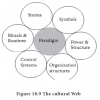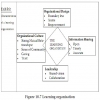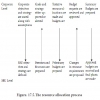Strategic Management - Strategy Implementation
Key Elements of Organizational Structure and Design
Posted On :
The key elements in organization structure and design are:
Key
Elements of Organizational Structure and Design
The key elements in organization structure and design are:
1. Departmentation
2. Chain of command
3. Span of control
4. Centralization and decentralization
5. Formalization
We will now examine each one of them and see how they affect the design questions
What type of arrangement is suitable for the effective functioning of the organization?
Should the chain of command be long or short? Should it allow lateral relationships?
How many employees should a supervisor manage?
Should the decision authority be concentrated at the top or diffused?
Should there be informal work relationships?
Once activities are divided based on work specialization common tasks are to be grouped together. This is called departmentalization. There are five bases for departmentation.
1. Functions
2. Geographical areas
3. Product
4. Process
5. Customers
Figure 18.1 to 18.5 illustrate the arrangements along with advantages and disadvantages

+ Efficiencies from putting together similar specialties and people with common skills, knowledge, and orientations.
+ Coordination with functional area
+ In-depth specialization
- Poor communication across functional areas
- Limited view of organizational goals

+ More effective and efficient handling of specific regional issues that arise
+ Serve needs of unique geographic markets better
- Duplication of functions
- Can feel isolated from other organizational areas

Source
Bombardier Company’s Annual Report
+ Allows specialization in particular products and services
+ Managers can become experts in their industry
+ Closer to customers
- Duplication of functions
- Limited view of organizational goals
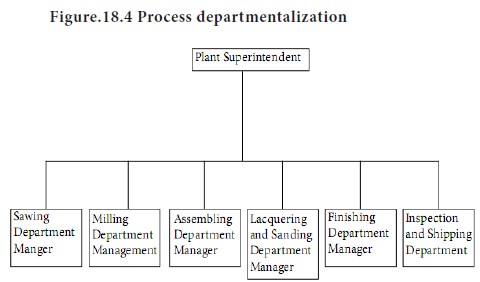
+ More efficient flow of work activities
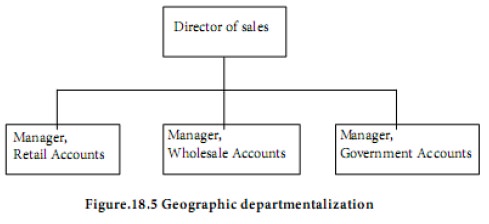
+ Specialists can meet Customers’ needs and problems
- Duplication of functions
- Limited view of organizational goals
Span of control (or supervision or management) refers to the number of employees a supervisor can effectively manage. Organizational levels exist since there is a limit to the number of people one can supervise effectively. This limit varies upon situations. Figure 18-6 shows span types and Table 18-1 discusses their advantages and disadvantages.
. A wide span is associated with few levels in the organization and a narrow span, many levels. The number of subordinates a manager can effectively supervisor ranges from three to eight. The number of people who directly report to a manager represent the manager ‘span of control’.

Ex: Sears, Roebuck & Co, etc, reported good
results with spans of control of over six. There were 36 managers reporting to
one boss and five reporting to one and both worked. Wider spans are preferred
today for less administrative expense and more self-management.


In some organizations, top managers make all the decisions and lower-level mangers and employees simply carry out their directives. At the other extreme are organizations in with decision making is pushed down to the managers who are close to the scene of action. The former organizations are highly centralized, and the latter are decentralized. Centralization describes the degree to which decision-making is concentrated at a single point in the organization. In contrast, the more that lower-level employees provide input or actually make decisions, the decentralization is more. Table 18-2 lists some of the features and factors that have been identified as influencing the amount of centralization or decentralization an organization.
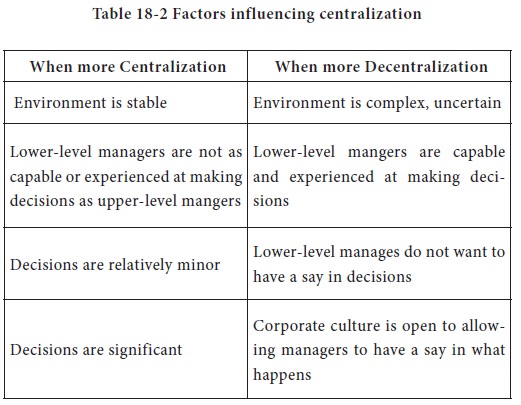
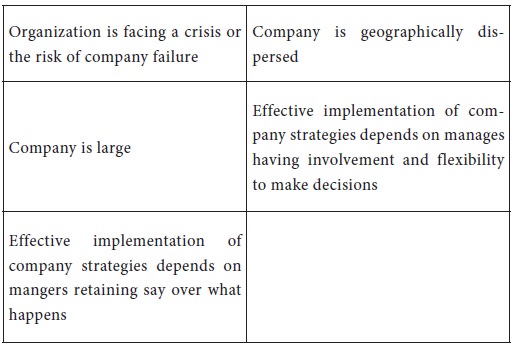
The key elements in organization structure and design are:
1. Departmentation
2. Chain of command
3. Span of control
4. Centralization and decentralization
5. Formalization
We will now examine each one of them and see how they affect the design questions
What type of arrangement is suitable for the effective functioning of the organization?
Should the chain of command be long or short? Should it allow lateral relationships?
How many employees should a supervisor manage?
Should the decision authority be concentrated at the top or diffused?
Should there be informal work relationships?
Departmentation
Once activities are divided based on work specialization common tasks are to be grouped together. This is called departmentalization. There are five bases for departmentation.
1. Functions
2. Geographical areas
3. Product
4. Process
5. Customers
Figure 18.1 to 18.5 illustrate the arrangements along with advantages and disadvantages
Functional Departmentalization

+ Efficiencies from putting together similar specialties and people with common skills, knowledge, and orientations.
+ Coordination with functional area
+ In-depth specialization
- Poor communication across functional areas
- Limited view of organizational goals
Geographical Departmentalization

+ More effective and efficient handling of specific regional issues that arise
- Duplication of functions
- Can feel isolated from other organizational areas

Source
Bombardier Company’s Annual Report
+ Allows specialization in particular products and services
+ Managers can become experts in their industry
+ Closer to customers
- Duplication of functions
- Limited view of organizational goals
Process Departmentalization

+ More efficient flow of work activities
-
Can only be used with certain types of products
Customer Departmentalization

+ Specialists can meet Customers’ needs and problems
- Duplication of functions
- Limited view of organizational goals
Chain of Command
Chain of command is the continuous line of authority that extends from upper organizational levels to
the lowest levels and clarifies who reports to whom. It helps employees answer
questions such as “who do I go to if I have a problem?” or “To whom am I
responsible?”
You can’t discuss the chain of command without discussing the other concepts: authority, responsibility and unity of command. Author-ity refers to the rights inherent in a managerial position to tell people what to do and to expect them to do it. This obligation or expectation to perform is known as responsibility. Finally, the unity of command principle (one of Fayol’s 14 principles of management) helps preserve the concept of a continuous line of authority. It states that a person should report to only one manager.
You can’t discuss the chain of command without discussing the other concepts: authority, responsibility and unity of command. Author-ity refers to the rights inherent in a managerial position to tell people what to do and to expect them to do it. This obligation or expectation to perform is known as responsibility. Finally, the unity of command principle (one of Fayol’s 14 principles of management) helps preserve the concept of a continuous line of authority. It states that a person should report to only one manager.
Span of Control
Span of control (or supervision or management) refers to the number of employees a supervisor can effectively manage. Organizational levels exist since there is a limit to the number of people one can supervise effectively. This limit varies upon situations. Figure 18-6 shows span types and Table 18-1 discusses their advantages and disadvantages.
. A wide span is associated with few levels in the organization and a narrow span, many levels. The number of subordinates a manager can effectively supervisor ranges from three to eight. The number of people who directly report to a manager represent the manager ‘span of control’.



Centralization and decentralization
In some organizations, top managers make all the decisions and lower-level mangers and employees simply carry out their directives. At the other extreme are organizations in with decision making is pushed down to the managers who are close to the scene of action. The former organizations are highly centralized, and the latter are decentralized. Centralization describes the degree to which decision-making is concentrated at a single point in the organization. In contrast, the more that lower-level employees provide input or actually make decisions, the decentralization is more. Table 18-2 lists some of the features and factors that have been identified as influencing the amount of centralization or decentralization an organization.


Formalization
Formalization refers to the degree to which jobs within the
organization are standardized and
the extent to which employee behavior is guided by rules and procedures. If a
job is highly formalized, then the person doing that job has a minimum amount
of discretion over what is to be done, when it’s to be done, and how he or she
could do it.
Tags : Strategic Management - Strategy Implementation
Last 30 days 3484 views












